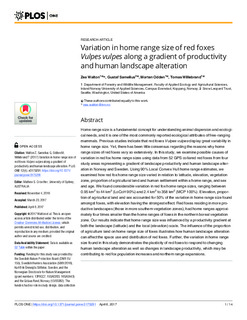Variation in home range size of red foxes Vulpes vulpes along a gradient of productivity and human landscape alteration
Journal article, Peer reviewed
Permanent lenke
http://hdl.handle.net/11250/2441047Utgivelsesdato
2017Metadata
Vis full innførselSamlinger
Originalversjon
10.1371/journal.pone.0175291Sammendrag
Home
range
size
is a fundamental
concept
for
understanding
animal
dispersion
and
ecologi-
cal
needs,
and
it is one
of the
most
commonly
reported
ecological
attributes
of free-ranging
mammals.
Previous
studies
indicate
that
red
foxes
Vulpes
vulpes
display
great
variability
in
home
range
size.
Yet,
there
has
been
little
consensus
regarding
the
reasons
why
home
range
sizes
of red
foxes
vary
so
extensively.
In this
study,
we
examine
possible
causes
of
variation
in red
fox
home
range
sizes
using
data
from
52
GPS
collared
red
foxes
from
four
study
areas
representing
a gradient
of landscape
productivity
and
human
landscape
alter-
ation
in Norway
and
Sweden.
Using
90%
Local
Convex
Hull
home
range
estimates,
we
examined
how
red
fox
home
range
size
varied
in relation
to latitude,
elevation,
vegetation
zone,
proportion
of agricultural
land
and
human
settlement
within
a home
range,
and
sex
and
age.
We
found
considerable
variation
in red
fox
home
range
sizes,
ranging
between
0.95
km
2
to 44
km
2
(LoCoH
90%)
and
2.4
km
2
to 358
km
2
(MCP
100%).
Elevation,
propor-
tion
of agricultural
land
and
sex
accounted
for
50%
of the
variation
in home
range
size
found
amongst
foxes,
with
elevation
having
the
strongest
effect.
Red
foxes
residing
in more
pro-
ductive
landscape
s (those
in more
southern
vegetation
zones),
had
home
ranges
approxi-
mately
four
times
smaller
than
the
home
ranges
of foxes
in the
northern
boreal
vegetation
zone.
Our
results
indicate
that
home
range
size
was
influenced
by
a productivity
gradient
at
both
the
landscape
(latitude)
and
the
local
(elevation)
scale.
The
influence
of the
proportion
of agriculture
land
on
home
range
size
of foxes
illustrates
how
human
landscape
alteration
can
affect
the
space
use
and
distribution
of red
foxes.
Further,
the
variation
in home
range
size
found
in this
study
demonstrates
the
plasticity
of red
foxes
to respond
to changing
human
landscape
alteration
as
well
as
changes
in landscape
productivity,
which
may
be
contributing
to red
fox
population
increases
and
northern
range
expansions.
